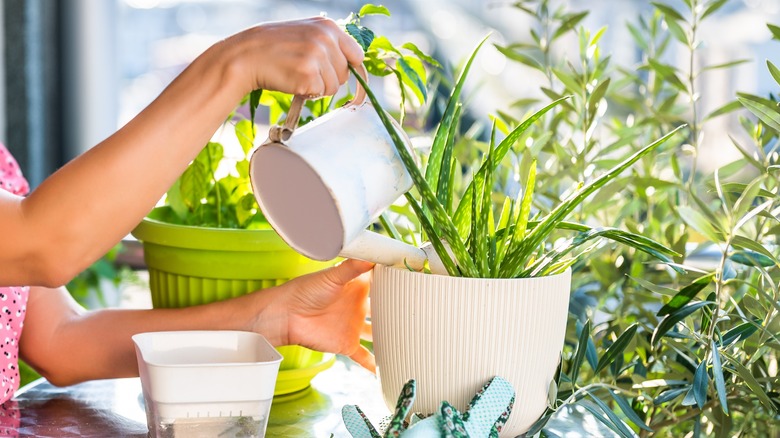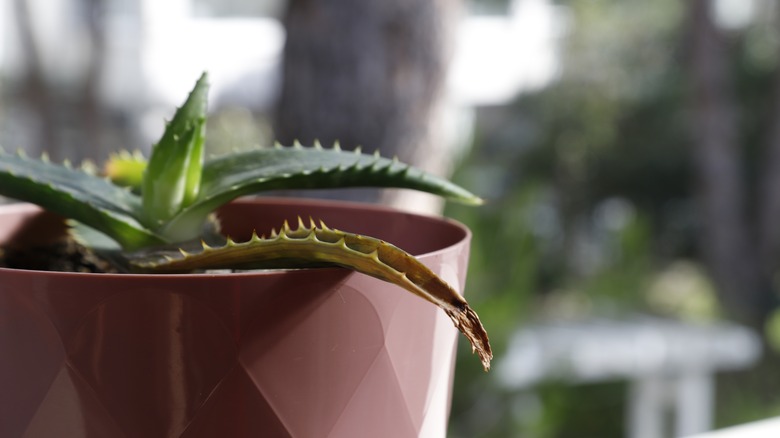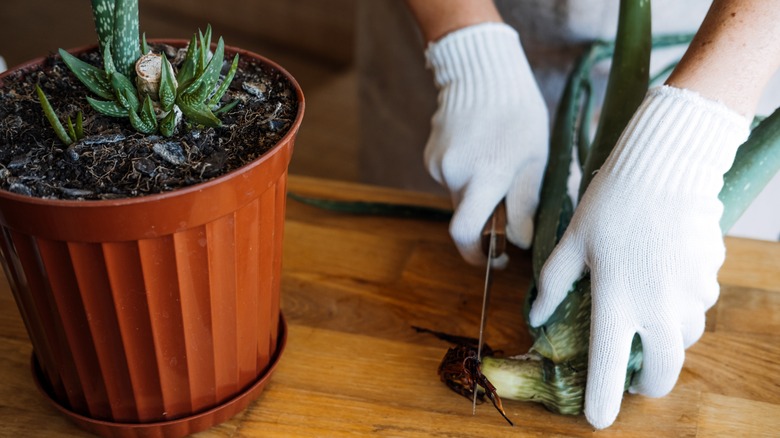How To Tell If Your Aloe Vera Plant Is Overwatered
Possibly the most popular member of the aloe family, aloe vera is a beloved succulent plant that is often kept as an indoor or outdoor potted plant. The long, spindly green leaves hold a viscous jelly that's often used to treat sunburns and other topical issues. Overall, aloe vera plants are pretty easy to take care of, as they are somewhat drought tolerant and don't require a bunch of fussy maintenance or pruning, but one of the most direct ways to send your aloe vera plant to an early grave is by overwatering.
Overwatering is a common aloe plant issue that you should keep an eye on as it can cause the plant to decay and even develop root rot, soft rot, fungal stem rot, and leaf rot. Over time, the plant will die out as a result. It can be hard to know if you're watering aloe vera too often. The two easiest methods of determining if an aloe plant is overwatered are by the sight and feel of the plant.
The signs of an overwatered aloe vera plant
If you're concerned about your aloe, take a good look at it. A healthy aloe vera plant's teeth-lined leaves are gray-green and should reach out from the center of the plant. Overwatering can explain why your aloe plant is turning brown. Some people might mistake this as a burn mark or a sign of dryness and add more water to compensate, but this will worsen the issue. Beyond color, look at how the leaves are resting — normally, they should look perky, standing up without the support of the planter pot or other aids. These leaves may begin to droop and sag as a result of overwatering.
If sight isn't enough to help you determine whether or not you're overwatering aloe vera, give it a feel. Be careful not to cut yourself on the teeth of the plant, but give it a gentle squeeze. Because it's filled with gel, it may have a little give but not feel overly squishy. If your aloe vera feels mushy like a banana mashed inside the peel, that's too soft and is a sign of plant rot. You may also feel bumps on the leaves, as the plant may have also developed patches of blisters called edema — these aren't sun blisters like humans get after a day at the beach, but rather, they're small pockets of collected excess water.
How to prevent and treat overwatered aloe vera
The good news is that aloe vera is a very hearty, resilient plant, so even if it's suffered from overwatering, you can breathe new life into your rotted aloe vera plant. Remove the plant, roots and all, from its pot. Gently shake off as much soil as possible, as this will help you to see if the rot has spread from the leaves to the root system. Trim any slimy, mushy parts of the roots using your scissors or a small knife, careful to avoid clipping any healthy roots. Allow the plant to air dry completely, which may take several days. Once certain traces of rot are eliminated, you can repot the plant in fresh soil — be sure to pick a planter with drainage holes and well-draining soil as a safeguard against overzealous watering.
If you found that your root system was entirely rotten, you may be able to propagate a new aloe plant from the healthy leaves — you can follow our guide to propagating aloe vera plants without roots. In the future, you can prevent overwatering aloe vera easily by only watering it every two to three weeks during growth months in the spring and summer, and even less in fall and winter.


